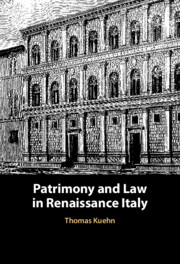Book contents
- Patrimony and Law in Renaissance Italy
- Patrimony and Law in Renaissance Italy
- Copyright page
- Contents
- Acknowledgments
- 1 Introduction
- 2 Bartolus and Family in Law
- 3 The Divisible Patrimony
- 4 Property of Spouses in Law in Renaissance Florence
- 5 Societas and Fraterna of Brothers
- 6 Fideicommissum and Law
- 7 Estate Inventories as Legal Instruments in Renaissance Italy
- 8 Prudence, Personhood, and Law in Renaissance Italy
- 9 Addendum
- 10 Conclusion
- Bibliography
- Index
7 - Estate Inventories as Legal Instruments in Renaissance Italy
Published online by Cambridge University Press: 24 February 2022
- Patrimony and Law in Renaissance Italy
- Patrimony and Law in Renaissance Italy
- Copyright page
- Contents
- Acknowledgments
- 1 Introduction
- 2 Bartolus and Family in Law
- 3 The Divisible Patrimony
- 4 Property of Spouses in Law in Renaissance Florence
- 5 Societas and Fraterna of Brothers
- 6 Fideicommissum and Law
- 7 Estate Inventories as Legal Instruments in Renaissance Italy
- 8 Prudence, Personhood, and Law in Renaissance Italy
- 9 Addendum
- 10 Conclusion
- Bibliography
- Index
Summary
The heir inherited not only the property but also the persona of the deceased, which meant the heir also assumed all debts and liabilities incumbent on the estate. That inherited liability could make an estate burdensome. In the course of the Middle Ages learned law developed the institution of repudiation of inheritance, by which one could decline an impoverished estate. But refusal to inherit ran against expectations of all parties, and could open the door to fraud and deception. Another device, aimed at limiting inherited liabilities so that heirs would accept an estate, was the formal inventory. One's liability would be limited to the contents entered therein and a guaranteed portion would go to the heir. Again, there was reason to fear fraud, and many cities such as Florence limited use of inventories to heirs who were minors. Inventories have proven to be useful historical sources for a variety of purposes, but they have to be used with care. The consilia of jurists on matters involving inventory illustrate what some of the problems were in trusting inventories, which relied for factual evidence on what witnesses, not always disinterested by any means, could provide.
- Type
- Chapter
- Information
- Patrimony and Law in Renaissance Italy , pp. 164 - 199Publisher: Cambridge University PressPrint publication year: 2022

